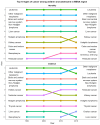Pediatric and adolescent cancer disparities in the Middle East and North Africa (MENA) region: incidence, mortality, and survival across socioeconomic strata
- PMID: 39736554
- PMCID: PMC11684239
- DOI: 10.1186/s12889-024-21155-8
Pediatric and adolescent cancer disparities in the Middle East and North Africa (MENA) region: incidence, mortality, and survival across socioeconomic strata
Abstract
Background: Cancer is one of the leading causes of death in children and adolescents, with a significant concentration in low and middle-income countries. Previous research has identified disparities in cancer incidence and mortality based on a country's level of development. The Middle East and North Africa (MENA) region comprises of countries with heterogeneous income and development levels. This study aims to investigate whether discrepancies in cancer incidence and mortality among children and adolescents exist in countries within the MENA region.
Materials and methods: Data on cancer incidence and mortality were drawn from the Global Burden of Disease Study (GBD) 2019 for all malignant neoplasms (including non-melanoma skin cancers). The analysis was restricted to children and adolescents aged less than 20 years. Mortality- to-Incidence ratios (MIR) were calculated as a proxy measure of survival for each cancer type and country and Spearman's correlation coefficient measured the association between socio-demographic index (SDI), incidence rates, mortality rates, and MIR.
Results: In 2019, cancer incidence in the MENA region was 4.82/100,000 population, while mortality rate was 11.65/100,000 population. Cancer incidence and mortality was higher among males compared to females. A marked difference was observed in cancer-related mortality rates between low-income and high-income countries. MIR was higher in low-income countries, particularly for males and specific cancer types such as liver, colon and rectum, brain and central nervous system (CNS) cancers, and non-Hodgkin lymphoma among others. A negative correlation was observed between a country's SDI and MIR (-0.797) and SDI and mortality rates (-0.547) indicating that higher SDI corresponds to lower MIR and lower mortality rates.
Conclusion: These findings highlight the need for evidence-based interventions to reduce cancer-related mortality and disease burden among children and adolescents, particularly in low-income countries within the region and for cancer types with the highest mortality rates. Additionally, efforts should focus on establishing registries to provide up-to-date national data on cancer incidence and mortality in countries within the region.
Keywords: Childhood cancer; Incidence; MENA region; Mortality rate; Mortality-to-incidence ratio; Socio-demographic index.
© 2024. The Author(s).
Conflict of interest statement
Declarations. Ethical approval and consent statement: Not applicable. Consent for publication: Not applicable. Competing interests: The authors declare no competing interests.
Figures





Similar articles
-
The burden of childhood and adolescent cancers in North Africa and the Middle East (NAME) region: findings from the Global Burden of Disease study 2019.BMC Pediatr. 2023 Mar 8;23(1):113. doi: 10.1186/s12887-023-03931-4. BMC Pediatr. 2023. PMID: 36890483 Free PMC article.
-
Socioeconomic and demographic disparities in the impact of digestive diseases in the middle East and North Africa (MENA) region.Int J Equity Health. 2025 Mar 27;24(1):85. doi: 10.1186/s12939-025-02448-9. Int J Equity Health. 2025. PMID: 40148874 Free PMC article.
-
Kidney cancer in the Middle East and North Africa region: a 30-year analysis (1990-2019).Sci Rep. 2024 Jun 14;14(1):13710. doi: 10.1038/s41598-024-64521-7. Sci Rep. 2024. PMID: 38877130 Free PMC article.
-
Cardiovascular disease burden in the Middle East and North Africa region.Curr Probl Cardiol. 2024 Mar;49(3):102341. doi: 10.1016/j.cpcardiol.2023.102341. Epub 2023 Dec 14. Curr Probl Cardiol. 2024. PMID: 38103814 Review.
-
[SENTIERI - Epidemiological Study of Residents in National Priority Contaminated Sites. Sixth Report].Epidemiol Prev. 2023 Jan-Apr;47(1-2 Suppl 1):1-286. doi: 10.19191/EP23.1-2-S1.003. Epidemiol Prev. 2023. PMID: 36825373 Italian.
Cited by
-
Epidemiology and socioeconomic factors of nonmelanoma skin cancer in the Middle East and North Africa 1990 to 2021.Sci Rep. 2025 May 23;15(1):17904. doi: 10.1038/s41598-025-99434-6. Sci Rep. 2025. PMID: 40410346 Free PMC article.
References
-
- Lam CG, Howard SC, Bouffet E, Pritchard-Jones K. Science and health for all children with cancer. Science. 2019;363:1182–6. - PubMed
-
- White Y, Castle VP, Haig A. Pediatric oncology in developing countries: challenges and solutions. J Pediatr. 2013;162:1090–1. 1091.e1. - PubMed
-
- Goss PE, Lee BL, Badovinac-Crnjevic T, Strasser-Weippl K, Chavarri-Guerra Y, St Louis J, et al. Planning cancer control in Latin America and the Caribbean. Lancet Oncol. 2013;14:391–436. - PubMed
-
- World Health Organization. CureAll framework: WHO global initiative for childhood cancer: increasing access, advancing quality, saving lives. World Health Organization; 2021.
MeSH terms
LinkOut - more resources
Full Text Sources
Medical
Research Materials

